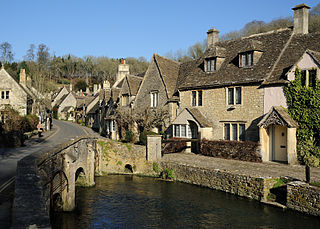
The Cotswolds is an area in south-central England, along a range of rolling hills that rise from the meadows of the upper Thames to an escarpment above the Severn Valley and Evesham Vale.

Gloucestershire is a county in South West England. The county comprises part of the Cotswold Hills, part of the flat fertile valley of the River Severn, and the entire Forest of Dean.

Chipping Campden is a market town in the Cotswold district of Gloucestershire, England. It is notable for its terraced High Street, dating from the 14th century to the 17th century.

The Cotswold Way is a 102-mile (164 km) long-distance footpath, running along the Cotswold Edge escarpment of the Cotswold Hills in England. It was officially inaugurated as a National Trail on 24 May 2007 and several new rights of way have been created.
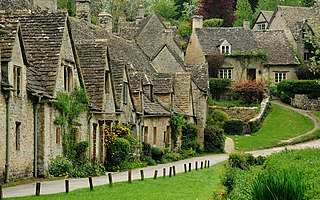
Bibury is a village and civil parish in Gloucestershire, England. It is on the River Coln, a Thames tributary that rises in the same (Cotswold) District. The village centre is 6+1⁄2 miles northeast of Cirencester. Arlington Row is a nationally notable architectural conservation area depicted on the inside cover of all British passports. It is a major destination for tourists visiting the traditional rural villages, tea houses and many historic buildings of the Cotswold District; it is one of six places in the country featured in Mini-Europe, Brussels.

Hawkesbury is a hamlet consisting of a few cottages around a triangular green. It is also the name of a civil parish in the South Gloucestershire unitary authority in England in which Hawkesbury itself lies, it is located west of Hawkesbury Upton, off the A46 road.

Stanton is a village and civil parish in Tewkesbury Borough, Gloucestershire, England. The village is a spring line settlement at the foot of the Cotswold escarpment, about 2+1⁄2 miles (4 km) southwest of Broadway in neighbouring Worcestershire. Broadway is Stanton's postal town. The 2011 Census recorded the parish's population as 198.
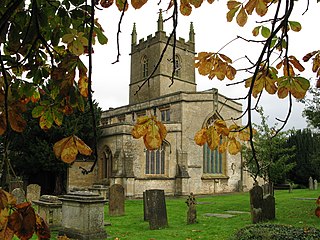
St Edward's Church is a medieval-built Church of England parish church, serving Stow-on-the-Wold ('Stow'), Gloucestershire.
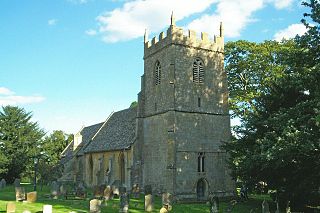
Ebrington is a village and civil parish in Gloucestershire, England, about 2 miles (3.2 km) from Chipping Campden. It has narrow lanes and tiny streets of Cotswold stone houses and cottages, many of which are thatched.

The Church of St. John Baptist, Cirencester is a parish church in the Church of England in Cirencester, Gloucestershire, England. It is a Grade I listed building.

The Church of St Mary the Virgin is a Church of England parish church in Meysey Hampton, Gloucestershire. It is in the Diocese of Gloucester and the archdeaconry of Cheltenham. It is a Grade II* listed building.
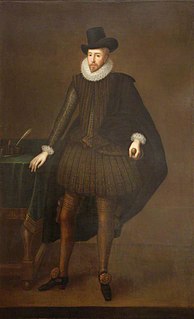
Baptist Hicks, 1st Viscount Campden was an English cloth merchant and politician who sat in the House of Commons between 1621 and 1628. King James I knighted Hicks in 1603 and in 1620 he was created a baronet.
Chipping Campden School is a non-selective secondary school and sixth form with academy status located in Chipping Campden, in the English county of Gloucestershire. Founded in c1440 the school celebrated its 575th birthday in 2015.

William Greville, of Chipping Campden in Gloucestershire and a Citizen of the City of London, was a prominent wool-merchant and is the ancestor of the present Greville Earls of Warwick. The Latin inscription on his ledger stone in Chipping Campden Church, which he rebuilt at his own expense, describes him as flos mercatorum lanar(iorum) tocius (totius) Angli(a)e, "the flower of the wool-merchants of all England". This language is reminiscent of that used to describe certain prominent knights such as Edward, the Black Prince (d.1376) who was described by Froissart as la fleur de toutte chevalerie dou monde and was likely intended to suggest a degree of equivalence between mercantile and martial activities". He was amongst the richest and most influential wool merchants of his era and was the leading purchaser of wool from the Cotswold Hills.

The Church of St Mary in Hawkesbury, South Gloucestershire, England was built in the 12th century. It is a Grade I listed building.

The Anglican Church of St Eadburga at Ebrington in the Cotswold District of Gloucestershire, England was built in the 13th century. It is a grade I listed building.

The Anglican Church of St Lawrence at Mickleton in the Cotswold District of Gloucestershire, England was built in the 12th century. It is a grade I listed building.

The Church of St Mary the Virgin is the parish church of Tetbury in the Cotswold District of Gloucestershire, England. It was built in 1781 incorporating elements of an earlier church. It is a grade I listed building.

The Anglican Church of St Peter within the grounds of Rendcomb College at Rendcomb in the Cotswold District of Gloucestershire, England was rebuilt in the 16th century. It is a grade I listed building.

Chipping Campden Town Hall is a municipal building in the High Street, Chipping Campden, Gloucestershire, England. The building, which is the meeting place of Chipping Campden Town Council, is a Grade II* listed building.




















